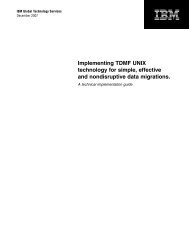A Primer for Healthcare Managers - IBM
A Primer for Healthcare Managers - IBM
A Primer for Healthcare Managers - IBM
Create successful ePaper yourself
Turn your PDF publications into a flip-book with our unique Google optimized e-Paper software.
Executive Summary<br />
In<strong>for</strong>mation technology (IT) outsourcing is an<br />
emerging phenomenon. With the increased use<br />
of IT to secure the nation and deliver in<strong>for</strong>mation<br />
and services, healthcare executives are looking <strong>for</strong><br />
innovative ways of quickly and effectively meeting<br />
the needs of the nation. IT outsourcing meets those<br />
needs by providing skilled IT personnel, state-ofthe-art<br />
applications, cost-effective infrastructure,<br />
and quick deployment. Although it carries potential<br />
benefits, IT outsourcing also comes with risks such<br />
as loss of control over service quality.<br />
This report provides managers with in<strong>for</strong>mation about<br />
scope, trends, and development, and with tools to<br />
meet the challenge of managing and succeeding at<br />
an IT outsourcing project. IT outsourcing is broadly<br />
defined as the utilization of external organizations<br />
<strong>for</strong> the production and provision of IT services.<br />
Managing an outsourced IT service becomes more<br />
complex when agencies are heavily involved in its<br />
production and provision. Recent market trends<br />
show signs that IT outsourcing is maturing and that<br />
established government contractors and integrated<br />
solution providers are emerging as winners. Recent<br />
developments have marked security (in<strong>for</strong>mation<br />
assurance) as a prominent concern <strong>for</strong> many organizations<br />
and a preference <strong>for</strong> the partnership model<br />
<strong>for</strong> IT outsourcing.<br />
Knowledge about costs and benefits of IT outsourcing<br />
allows managers to critically evaluate their<br />
options and later think creatively about the best<br />
way to achieve their goals. Benefits include access<br />
to advanced technology, meeting the demand <strong>for</strong><br />
skilled IT personnel, quick deployment, flexibility<br />
in choosing appropriate technology, cash flow<br />
management, and cost savings.<br />
On the other hand, there are also costs/risks. The<br />
most significant of these include loss of control over<br />
service quality, security vulnerability, disruption of<br />
services, management complexity, lengthy procurement<br />
process, union pressure, and budgetary uncertainty.<br />
With in-depth knowledge about costs/risks,<br />
managers can manage IT outsourcing projects more<br />
effectively.<br />
The tools offered by this primer include guidelines<br />
and the process-oriented way of effectively managing<br />
IT outsourcing. To be successful, managers need<br />
to shift their focus from procurement to service and<br />
relationship management. Moreover, resource input<br />
into the IT outsourcing relationship should be<br />
provided and sustained throughout its life cycle.<br />
Another critical success factor is the development and<br />
upgrade of contract and service management capacity.<br />
In the management of a service contract, frequent<br />
quality communication needs to be in place to foster<br />
partnerships and cope with changing service needs.<br />
The process model <strong>for</strong> managing an IT outsourcing<br />
project consists of five phases: (1) determining a<br />
sourcing strategy, (2) analyzing sourcing needs and<br />
the operational relationship, (3) selecting a vendor<br />
and negotiating contracts, (4) making the transition<br />
to the service provider, and (5) managing the<br />
per<strong>for</strong>mance of the service provider. Each phase<br />
flows directly from the previous one. The specific<br />
guidelines <strong>for</strong> each juncture of decision making are<br />
detailed in the section on recommendations.<br />
Outsourcing: Opportunities<br />
and Challenges<br />
Background<br />
<strong>Healthcare</strong> organizations are increasingly compelled<br />
to be innovative in looking <strong>for</strong> new ways to manage<br />
with greater efficiency. With technology integrated<br />
into every facet of a modern organization, efficient<br />
deployment and use of in<strong>for</strong>mation technologies (IT)<br />
has the attention of top management. Outsourcing<br />
is clearly among the popular approaches that are<br />
considered when healthcare organizations seek to<br />
reduce operating costs of IT, improve their focus,<br />
and expand the resources available to the organization.<br />
Total spending on IT outsourcing is expected to<br />
exceed $100 billion dollars in 2005 (Casale, 2001).<br />
<strong>Healthcare</strong> organizations are recognizing the<br />
benefits of outsourcing IT and are moving to take<br />
advantage of vendor in<strong>for</strong>mation infrastructures. The<br />
contracting partnership between Perot Systems and<br />
Harvard Pilgrim Health Care, New England’s oldest<br />
and most prestigious nonprofit health maintenance<br />
organization, is an example of the level of comprehensive<br />
IT support that has been negotiated in the<br />
healthcare industry. Harvard Pilgrim agreed in 1999<br />
<strong>IBM</strong> Center <strong>for</strong> <strong>Healthcare</strong> Management 3

















